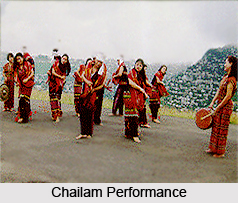 Chailam is one of the important dances practiced in the Mizoram state of India. This folk dance is performed by the tribes of Mizoram. It is mainly practiced during the festival of Chapchar kut which is regarded as one of the most significant festivals of Mizo people. Every year, the people of Mizoram organize this festival with great grandeur and Chailam is an integral part of this festival. Chailam embodies the spirit of joy among the people.
Chailam is one of the important dances practiced in the Mizoram state of India. This folk dance is performed by the tribes of Mizoram. It is mainly practiced during the festival of Chapchar kut which is regarded as one of the most significant festivals of Mizo people. Every year, the people of Mizoram organize this festival with great grandeur and Chailam is an integral part of this festival. Chailam embodies the spirit of joy among the people.
Performance of Chailam
Chailam is performed in a group and both men and women enthusiastically participate in this dance. The steps of this festive dance are simple yet graceful. The male and female dancers stand alternatively in the shape of a circle. The women stand holding on to the waist of the men and the men hold on to their shoulders. Musical instruments like the drums and the mithuns horns usually accompany the dance. The musicians who play the drums and mithuns horns stand in the middle of the circle. The musician choreographs the dance. The dance starts on the fourth stroke of the drum. The dancers sway from left to right according to the drum beats. While dancing, all the participants sing in chorus. There is no binding on time; the dance can continue for long hours. In the earlier days, the performers used to drink rice beer while dancing and singing. Chailam has four versions - Chailam I, Chailam II, Chailam III and Chailam IV.
Costume of Chailam
The participants wear colourful traditional attires that feature the rich creative culture of the Mizo people. In order to complete the get up, the female dancers also wear ethnic jewelleries which include necklace, bangle and earring. The dance and the costume together create an exhilarating atmosphere for the audience.
Mythological Story of Chailam
There is a legend behind this dance. Once King and his men went for hunting however they were unable to kill. On seeing the disappointment of his men he consoles them by inviting them to have rice beer. Thereafter, the men resorted to singing and dancing that was followed by a grand feast. Since then this dance is being performed during the festival.



















